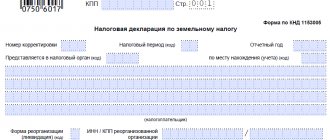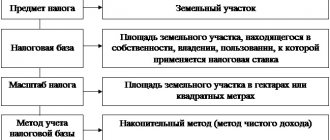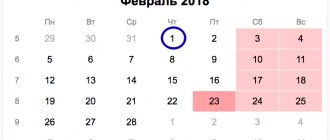Legal entities who have the right of perpetual use or who own land plots are required to file a land tax return. Organizations to which tax benefits are applied in accordance with Art. 395 of the Tax Code of the Russian Federation (exempt from taxation). It is possible not to submit a declaration only if the land plot is not recognized as an object of taxation (clause 2 of Article 389 of the Tax Code of the Russian Federation).
The land tax declaration is submitted to the tax office at the location of the land plot (clause 1 of Article 398 of the Tax Code of the Russian Federation). If an organization owns several plots located on the territory of one municipality, in agreement with the Federal Tax Service, you can submit one declaration to one inspection, filling out a separate section 2 for each plot. Other tax departments must be notified of this in writing.
If the plots are located in different municipalities, declarations are submitted to each Federal Tax Service, which controls the territories.
Taxpayers from the largest category submit declarations to the tax office at their place of registration, regardless of the number and location of land plots.
Deadlines for payment of land tax and tax period for individuals and legal entities
Land tax and advance payments for it are required to be made by taxpayers based on the procedure and deadlines established by the regulations of the representative bodies of municipalities (Article 397 of the Tax Code of the Russian Federation).
For legal entity taxpayers (organizations and individual entrepreneurs), the tax payment deadline cannot be set earlier than February 1 of the year following the current one. Advance payments cannot be collected before the last day of the month following the expired quarter, that is, you do not need to make an advance tax payment before May 1, August 1, and November 1.
For individual taxpayers (citizens), the deadline for paying land tax cannot be set later than December 1 of the year following the expired tax period (calendar year).
The tax period in accordance with Article 393 of the Tax Code of the Russian Federation, Chapter 31 “Land Tax” is a calendar year.
The reporting period for legal entities (organizations and individual entrepreneurs) is the first, second and third quarters of the calendar year. The representative body of each municipality has the right not to determine the reporting period at all.
This might also be useful:
- Tax calendar for June 2021 for individual entrepreneurs
- What income is not subject to personal income tax in 2021?
- Advance payment under the simplified tax system for the 1st quarter of 2021
- IP reporting on a patent
- Limits for calculating insurance premiums in 2020
- Instructions for filling out 3-NDFL for 2021 in the “Declaration” program
Is the information useful? Tell your friends and colleagues
Dear readers! The materials on the TBis.ru website are devoted to typical ways to resolve tax and legal issues, but each case is unique.
If you want to find out how to solve your specific issue, please contact the online consultant form. It's fast and free!
How is the deadline for paying land tax determined?
Before the adoption of the Federal Law of July 27, 2010, which introduced significant changes to Chapter 31 of the Tax Code, there was confusion regarding payment deadlines for citizen taxpayers. The entire tax was divided into three parts of payments at different times, which confused many.
The new procedure, starting January 1, 2021, abolished advance payments for individuals, as a result of which a single deadline for tax payment was determined - no later than December 1 of the year following the end.
Specific payment dates are determined by the “standards” of the representative bodies of municipalities in each specific region.
What is transport tax
Road toll is collected from vehicle owners.
The tax is paid once a year, and the funds received go to the accounts of regional budgets.
There is no single rate for this tax. Its size is calculated for each car owner and depends on the region, the power of the vehicle and the period of use.
The obligation to pay is assigned to both individuals and legal entities to whom the vehicle is registered. Transferring a vehicle by proxy does not exempt the owner from paying - the obligation to make timely payment lies with the one who registered the car.
To better navigate the legislation, future and current motorists are advised to study in more detail what a transport tax is.
Where to submit the declaration?
As a general rule, on the territory of the Russian Federation, the land tax declaration is submitted to the Federal Tax Service at the location of the land plot (clause 1 of Article 398 of the Tax Code of the Russian Federation).
However, for organizations included in the category of largest taxpayers, they are required to submit a declaration to the inspectorate with which they are registered (clause 4 of Article 398 of the Tax Code of the Russian Federation).
If an organization has several lands at its disposal, all of them are located in the territories of different municipalities, while such territories are controlled by one tax office, then it is allowed to submit one general declaration. In the general declaration for each site, the 2nd section of the document will be filled out separately (letter of the Federal Tax Service of the Russian Federation dated 08/07/2015 No. BS-4-11/13839).
It is not necessary to submit such a declaration to all inspections; it is enough to submit one, and simply notify the others about it.
If the land plots of a large organization are located in different municipalities, which have their own tax authorities, then each municipality must pay tax in proportion to its share.
Attention! If a land tax declaration is not submitted on time, administrative and tax liability arises, expressed in Article 2.1 of the Code of Administrative Offenses of the Russian Federation and Article 106 of the Tax Code of the Russian Federation.
The fine according to Article 119 of the Tax Code of the Russian Federation is 5% of the amount of tax payable (additional payment) according to the declaration, but not transferred to the local budget within a certain period. As a result, the fine will have to be paid for each full and partial month overdue from the date determined for filing the declaration.
The final amount of the fine for the entire period of late payment should not exceed 30% of the tax amount according to the declaration and cannot be less than 1 thousand rubles.
If the tax was paid in full on time, but the declaration was not submitted on time, you will need to pay 1 thousand rubles - the minimum fine. If only part of the tax liability has been paid, the penalty will be calculated from the remaining amount of the required payment.
How to fill out the declaration correctly?
Today, the form and rules for filling out the declaration are used, approved by order of the Federal Tax Service of Russia dated October 28, 2011 No. ММВ-7-11 / [email protected] (as amended on November 14, 2013).
When filling out the declaration, there are some important points to consider:
- When filling out the declaration manually, you are allowed to use a pen with a blue or black tip;
- Various corrections or blots in the declaration must be marked by a tax official;
- Only one value is indicated per row cell;
- If there is no value in the cell (an empty “cell”), a dash is placed;
- The pages of the declaration must be numbered;
- Each page of the document must be printed on a separate sheet;
- Do not damage the paper in any way, including staple or staple it;
- It is not permitted to use corrective agents;
- The text must be written in printed characters only;
- Cost indicators are written in full rubles (rounded). For indicator values less than 50 kopecks, the remainder is simply discarded; for 50 or more kopecks, the amount is rounded to the nearest ruble.
According to the rules, the declaration is drawn up in two copies. One copy remains with the tax office, and the second with the taxpayer. Completed declarations can be sent by “regular” mail or by email.
The “Title Book” is filled out in the standard manner, like all tax returns. It contains information about the organization and the tax return being filed.
The title page of the declaration is filled out by the taxpayer (representative of the organization), except for the section “To be completed by a tax inspector.”
The title page contains the following information:
- TIN (taxpayer identification number) and KPP (reason code for registration with the tax authorities) for the organization;
- Correction number. The new declaration indicates “0—”, the updated one states “1–”, “2–”, etc.;
- Taxable period. In our case, the tax period is 1 year - code 34;
- The reporting year for which the declaration is submitted;
- Code of the tax office to which the declaration is submitted;
- Code for submitting a land tax return: as a rule, this is number 270 “At the location of the land plot (share of the land plot”);
- Full name of the organization. It must correspond to the name in the constituent documents (Latin transcription is also indicated in the name);
- Code of the type of economic activity in accordance with the new classifier OKVED 2 (All-Russian classifier of types of economic activity OK 029-2014, approved by Order of Rosstandart of January 31, 2014 No. 14-st., used since 2017);
- Taxpayer contact telephone number;
- Number of pages of the declaration;
- The number of pages of supporting documentation attached to the declaration.
The title page has a separate section “I confirm the accuracy and completeness of the information specified in this declaration.” Here either the number “1” or the number “2” is placed.
The number “1” is entered if the accuracy and completeness of the information is confirmed directly by the head of the taxpayer organization or the individual taxpayer entrepreneur.
The number “2” is written if the accuracy and completeness of the information is confirmed by the taxpayer’s representative (authorized person).
Let's move on to section 1 of the declaration.
Section 1 contains information about:
- Amounts of fees payable;
- Amounts of advance payments.
Section 1 of the land tax return includes two blocks of lines 010-040. Here's the details:
| First section line | What you need to indicate |
| 010 | KBK (RF budget classification code) – the value required to pay the amount of land tax according to the budget classification |
| 020 | OKTMO code (All-Russian Classifier of Territories of Municipal Entities), in accordance with which land tax is paid |
| 021 | Accrued amount of land tax payable to the budget for the tax period according to the taxpayer |
| 023 | The amount of the advance amount for land tax that is required to be paid in the first quarter of the current year |
| 025 | The amount of the advance amount for land tax that is required to be paid in the second quarter of the current year |
| 027 | The amount of the advance amount for land tax that is required to be paid in the third quarter of the current year |
| 030 | The amount of accrued land tax payable according to the taxpayer in accordance with the codes KBK and OKTMO. This value is calculated as the difference between the accrued amount in line 021 and the advance amounts 023, 025, 027. If the final value is negative, then a dash is placed in the column, if positive, then it is written down. There simply cannot be a negative tax payable |
| 040 | The amount of land tax determined to be reduced based on the results of the tax period, which is calculated as the difference between the accrued amount in line 021 and advance amounts 023, 025, 027. In this column, if the value is negative, then it is entered. If positive, then a dash. |
Section 2 of the land tax declaration is required in order to determine and calculate the amount of the fee for the reporting period (calendar year). Section 2 is filled out for each land plot and each share in the plot separately, if the owner organization has several of them.
In the second section for each land plot or share the following is indicated:
- Cadastral number and cadastral value of the land plot;
- KBK;
- OKTMO code of the municipality within whose territory the land plot is located according to the All-Russian Classifier approved by Order of Rosstandart dated June 14, 2013 No. 159-st;
- Land category code based on the Directory approved by Order of the Federal Tax Service of Russia dated October 28, 2011 No. ММВ-7-11/696;
- Tax rate;
- The tax base;
- The amount of tax assessed and payable.
If the organization has certain rights to preferential taxation, then lines 070 and 080 should be filled out.
In line 130 of section 2, the tax base is filled in. The tax base is based on the cadastral value of the land plot (if it has not been established, then the standard value of the land) as of January 1 of the reporting year.
It is important to monitor changes in the form and procedure for filling out tax returns. More detailed instructions on filling out a land tax return are available on the official website of the Federal Tax Service of the Russian Federation www.nalog.ru.
Thus, it is necessary to submit a land tax return on time, while filling out each line properly. In order for the declaration to be accepted by regulatory authorities, the information in it (declaration form, BCC, tax rates, etc.) should be taken from official resources.
Inheritance of the right to lease a land plot is regulated by 1112 articles of the Civil Code of the Russian Federation. How is the fee for an easement on a land plot determined? We talked about it here.
A sample application for preliminary approval of the provision of a land plot can be downloaded here.
Procedure for paying the transport fee
For organizations, the rules for settlements with the budget remain the same. They fill out a special payment document (payment order or cash expense application) to transfer funds to pay the tax.
Please note that the rules for filling out payment slips are changing from 01/01/2021 regarding payments to the budget. Transport tax is no exception; payment by legal entities is made according to new rules.
KBK remains an important requisite when filling out documents for payment of transport tax. For 2021, use the following budget classification codes:
- 182 1 0600 110 - when paying the tax itself;
- 182 1 0600 110 - when transferring penalties;
- 182 1 0600 110 - when paying off fines.
The BCC for transport tax has not changed.







